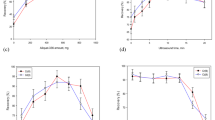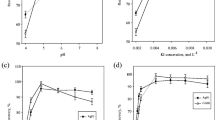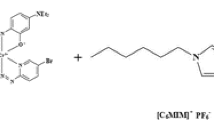Abstract
A simple, rapid and eco-friendly microextraction method was developed for the determination and preconcentration of zinc (Zn) and chromium (Cr) from grain products by ultrasonic-assisted ionic liquid dispersive liquid-liquid microextraction (UA-IL-DLLME) combined with flame atomic absorption spectrometry (FAAS). Quercetin (2-(3,4-dihydroxyphenyl)-3,5,7-trihydroxy-4H-chromen-4-one dihydrate) was used for the complexation of Zn(II) and Cr(III) ions at different pHs. The 1-hexyl-3-methylimidazolium bis[(trifluoromethyl) sulfonyl]imide ([Hmim][NTf2] and acetonitrile were used as extraction solvent and dispersive solvent, respectively. To provide quantitative extraction of analytes, important experimental variables such as pH of sample solution, temperature, ultrasonic time, amount of chelating agent, amount of ionic liquid, type and amount of dispersive solvent, and interference effect were extensively studied and optimized. The detection limits and operating ranges for Zn(II) and Cr(III) using the optimized conditions were 7.5, 25–450 and 2.4, 8–300 μg L−1, respectively. For the validation of the proposed method, the certified reference material was tested using the standard addition method. After microwave digestion analysis of grain products, relative standard deviations (RSDs%) and recoveries were ranged from 1.2 to 2.3% and from 91.2 to 103.7%, respectively. The UA-IL-DLLME method has been successfully applied for the determination of Zn and Cr in grain samples (chickpea, broad bean, pea, beans, and wheat).

Similar content being viewed by others
References
Gavrilescu M, Demnerová K, Aamand J, Agathos S, Fava F (2015) Emerging pollutants in the environment: present and future challenges in biomonitoring, ecological risks and bioremediation. New Biotechnol 32(1):147–156
Tepanosyan G, Maghakyan N, Sahakyan L, Saghatelyan A (2017) Heavy metals pollution levels and children health risk assessment of Yerevan kindergartens soils. Ecotoxicol Environ Saf 142:257–265
Özturan K, Atasever M (2018) Mineral elements and heavy metals in milk and dairy products. Atatürk Üniversitesi Veteriner Bilimleri Dergisi 13(2):229–241
Kirchmann H, Börjesson G, Kätterer T, Cohen Y (2017) From agricultural use of sewage sludge to nutrient extraction: a soil science outlook. Ambio 46(2):143–154
Mustafa G, Komatsu S (2016) Toxicity of heavy metals and metal-containing nanoparticles on plants. Biochim Biophys Acta (BBA) Proteins Proteomics 1864(8):932–944
Pandey R (2015) Mineral nutrition of plants. In: Plant biology and biotechnology. Springer, New Delhi, pp 499–538
Zhang J, Wang S, Song S, Xu F, Pan Y, Wang H (2019) Transcriptomic and proteomic analyses reveal new insight into chlorophyll synthesis and chloroplast structure of maize leaves under zinc deficiency stress. J Proteome 199:123–134
Bharani V, Sathyaraj S, Sinha A, Sugankumar D, Osborne JW (2015) A survey on the accumulation of chromium in plants near various tannery industries of Vellore district, TN. Res J Pharm Tech 8(9):1205
Pandey G, Madhuri S (2014) Heavy metals causing toxicity in animals and fishes, research journal of animal. Vet Fish Sci 2(2):17–23
Zhang Y, Lee HK (2012) Ionic liquid-based ultrasound-assisted dispersive liquid–liquid microextraction followed high-performance liquid chromatography for the determination of ultraviolet filters in environmental water samples. Anal Chim Acta 750:120–126
Öztan S, Düring RA (2012) Microwave assisted EDTA extraction—determination of pseudo total contents of distinct trace elements in solid environmental matrices. Talanta 99:594–602
Soylak M, Unsal YE, Yilmaz E, Tuzen M (2011) Determination of rhodamine B in soft drink, waste water and lipstick samples after solid phase extraction. Food Chem Toxicol 49(8):1796–1799
Gürkan R, Altunay N, Yıldırım E (2016) Combination of ultrasonic-assisted cloud point extraction with flame AAS for preconcentration and determination of trace amounts of silver and cadmium in dried nut and vegetable samples. Food Anal Methods 9(11):3218–3229
Elik A, Demirbas A, Altunay N (2019) Developing a new and simple natural deep eutectic solvent based ultrasonic-assisted microextraction procedure for determination and preconcentration of as and se from rice samples. Anal Methods 11:3429–3438
Altunay N, Elik A, Gürkan R (2019) Vortex assisted-ionic liquid based dispersive liquid liquid microextraction of low levels of nickel and cobalt in chocolate-based samples and their determination by FAAS. Microchem J 147:277–285
Zhang H, Chen X, Jiang X (2011) Determination of phthalate esters in water samples by ionic liquid cold-induced aggregation dispersive liquid–liquid microextraction coupled with high-performance liquid chromatography. Anal Chim Acta 689(1):137–142
Zeeb M, Mirza B, Zare-Dorabei R, Farahani H (2014) Ionic liquid-based ultrasound-assisted in situ solvent formation microextraction combined with electrothermal atomic absorption spectrometry as a practical method for preconcentration and trace determination of vanadium in water and food samples. Food Anal Methods 7(9):1783–1790
Elyasi M, Khalilzadeh MA, Karimi-Maleh H (2013) High sensitive voltammetric sensor based on Pt/CNTs nanocomposite modified ionic liquid carbon paste electrode for determination of Sudan I in food samples. Food Chem 141(4):4311–4317
Escudero LB, Wuilloud RG, Olsina RA (2013) Sensitive determination of thallium species in drinking and natural water by ionic liquid-assisted ion-pairing liquid–liquid microextraction and inductively coupled plasma mass spectrometry. J Hazard Mater 244:380–386
Biata NR, Nyaba L, Ramontja J, Mketo N, Nomngongo PN (2017) Determination of antimony and tin in beverages using inductively coupled plasma-optical emission spectrometry after ultrasound-assisted ionic liquid dispersive liquid-liquid phase microextraction. Food Chem 237:904–911
Altunay N, Bingöl D, Elik A, Gürkan R (2019) Vortex assisted-ionic liquid dispersive liquid-liquid microextraction and spectrophotometric determination of quercetin in tea, honey, fruit juice and wine samples after optimization based on response surface methodology. Spectrochim Acta A Mol Biomol Spectrosc 221(5):117166
Zeeb M, Farahani H, Papan MK (2016) Determination of atenolol in human plasma using ionic-liquid-based ultrasound-assisted in situ solvent formation microextraction followed by high-performance liquid chromatography. J Sep Sci 39(11):2138–2145
Shariati S, Bozorgzadeh E, Shariati F, Safa F (2018) Ionic liquid based ultrasound-assisted emulsification microextraction for preconcentration of phenol using central composite design. J Anal Chem 73(1):36–41
Magiera S, Sobik A (2017) Ionic liquid-based ultrasound-assisted extraction coupled with liquid chromatography to determine isoflavones in soy foods. J Food Compos Anal 57:94–101
Werner J (2016) Determination of metal ions in tea samples using task-specific ionic liquid-based ultrasound-assisted dispersive liquid–liquid microextraction coupled to liquid chromatography with ultraviolet detection. J Sep Sci 39(8):1411–1417
Zhang J, Zong A, Xu T, Zhan P, Liu L, Qiu B, Tian H (2018) A novel method: ionic liquid-based ultrasound-assisted extraction of polyphenols from Chinese purple yam. Nat Prod Res 32(7):863–866
Werner J (2018) Ionic liquid ultrasound-assisted dispersive liquid-liquid microextraction based on solidification of the aqueous phase for preconcentration of heavy metals ions prior to determination by LC-UV. Talanta 182:69–73
Escandar GM, Sala LF (1991) Complexing behavior of rutin and quercetin. Can J Chem 69(12):1994–2001
Ravichandran R, Rajendran M, Devapiriam D (2014) Antioxidant study of quercetin and their metal complex and determination of stability constant by spectrophotometry method. Food Chem 146:472–478
Fan PM, Wang B (2009) Molecular recognition characteristics of quercetin’s metal-complexing imprinted polymer. Chem J Chin Univ 30(12):2514–2520
Woźnicka E, Pieniążek E, Zapała L, Trojnar I, Kopacz M (2015) New sulfonic derivatives of quercetin as complexing reagents: synthesis, spectral, and thermal characterization. J Therm Anal Calorim 120(1):351–361
Kopacz M (2003) Quercetin-and morinsulfonates as analytical reagents. J Anal Chem 58(3):225–229
Zhao L, Zhong S, Fang K, Qian Z, Chen J (2012) Determination of cadmium (II), cobalt (II), nickel (II), lead (II), zinc (II), and copper (II) in water samples using dual-cloud point extraction and inductively coupled plasma emission spectrometry. J Hazard Mater 239:206–212
Hashemi M, Daryanavard SM (2012) Ultrasound-assisted cloud point extraction for speciation and indirect spectrophotometric determination of chromium (III) and (VI) in water samples. Spectrochim Acta A Mol Biomol Spectrosc 92:189–193
Pytlakowska K, Kozik V, Matussek M, Pilch M, Hachuła B, Kocot K (2016) Glycine modified graphene oxide as a novel sorbent for preconcentration of chromium, copper, and zinc ions from water samples prior to energy dispersive X-ray fluorescence spectrometric determination. RSC Adv 6(49):42836–42844
Majidi B, Shemirani F (2012) Salt-assisted liquid-liquid microextraction of Cr (VI) ion using an ionic liquid for preconcentration prior to its determination by flame atomic absorption spectrometry. Microchim Acta 176(1–2):143–151
Xiong W, Cheng C, Yang Y (2015) Determination of total chromium in tea samples by suspension dispersive solid phase extraction combined with silver nanoparticles and using flame atomic absorption spectrometry. Anal Methods 7(5):2093–2099
Safari M, Nojavan S, Davarani SSH, Morteza-Najarian A (2013) Speciation of chromium in environmental samples by dual electromembrane extraction system followed by high performance liquid chromatography. Anal Chim Acta 789:58–64
Rajabi M, Asemipour S, Barfi B, Jamali MR, Behzad M (2014) Ultrasound-assisted ionic liquid based dispersive liquid–liquid microextraction and flame atomic absorption spectrometry of cobalt, copper, and zinc in environmental water samples. J Mol Liq 194:166–171
Khazaeli E, Haddadi H, Zargar B, Hatamie A (2016) Response surface methodology based on central composite design as a chemometric tool for optimizing dispersive liquid–liquid microextraction for determining ultra-trace amounts of zinc in oil and water samples. Anal Methods 8(25):5101–5110
Author information
Authors and Affiliations
Corresponding author
Ethics declarations
Conflict of Interest
The authors declare that they have no conflicts of interest.
Ethical Approval
This article does not contain any studies with human or animal subjects.
Additional information
Publisher’s Note
Springer Nature remains neutral with regard to jurisdictional claims in published maps and institutional affiliations.
Highlights
• Simultaneous trace analysis of zinc and chromium was demonstrated.
• Ultrasonic-assisted ionic liquid dispersive liquid-liquid microextraction in sample preparation.
• The accuracy of the proposed method was evaluated by certified reference material.
• [Hmim][NTf2] as an extractant was efficiently used for preconcentration of Zn and Cr.
• Microwave digestion was applied to compare the results.
Electronic Supplementary Material
ESM1
(PDF 359 kb)
Rights and permissions
About this article
Cite this article
Elik, A., Demirbas, A. & Altunay, N. Analysis of Zinc and Chromium in Grain Samples Using Ionic Liquid-Based Ultrasound-Assisted Microextraction Followed by Flame-AAS After Microwave Digestion. Biol Trace Elem Res 198, 697–706 (2020). https://doi.org/10.1007/s12011-020-02071-5
Received:
Accepted:
Published:
Issue Date:
DOI: https://doi.org/10.1007/s12011-020-02071-5




